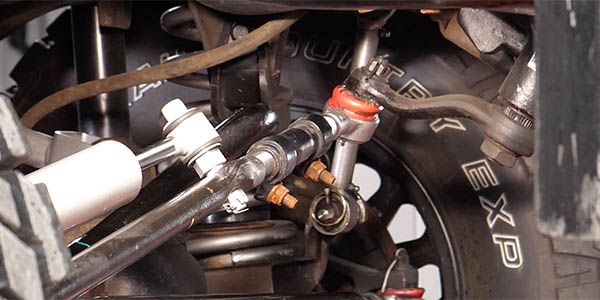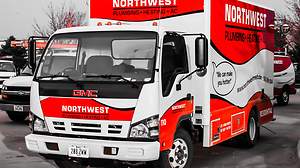
Click Here to Read More
Andrew Markel here, and we’re talking with Dave Grasso from Dorman Products, in regards to a kit that can help solve a very common problem on some Jeep Wrangler models that is very concerning for the customer. So Dave, what’s the problem for the customer?
Dave Grasso:
A common experience that many Jeep, and even some truck owners, will have is what they call a wobble in the front end. It can happen when they hit a pothole, it can happen at different speeds. But what it really is, is it’s a four to 10 hertz oscillation of the wheels. The problem is, it’s happening at different rates. So what the customer experience is, is they hit a pot pothole and their wheels start moving in different directions. They experience their wheel violently shake from side to side, and often quickly identify that there’s a problem with their steering system, a problem with their suspension, have to take it in to get it looked at at the shop.
Andrew Markel:
How does the customer stop this from happening on the road? Do they have to slow down to the side of the road to get it to stop?
Dave Grasso:
Yeah, I can tell you from experience it’s happened to me, I honestly thought something came loose, something detached. I quickly pulled to the side of the highway, had to get under the vehicle to understand is everything’s still attached? Slowly get to speed. Many will simply call a tow truck and say, “Hey, that’s too scary. I got to get this thing to a shop. Something’s wrong.”
Andrew Markel:
I’ve seen the videos on YouTube of this, the wheels going back and forth, and it’s very, very scary.
Dave Grasso:
Absolutely.
Andrew Markel:
So you guys have a kit to help prevent this problem on some Wrangler models. Which Wrangler models does it cover?
Dave Grasso:
Sure. This kit covers the TJ models, ’97 to ’02, I believe. They’re going to have the JK coming out very shortly. Really, it’s a comprehensive solution to a problem that is often misdiagnosed. A problem that’s often misunderstood. So what we’ve done is we’ve tried to take that misdiagnosis out of it, provide clarity, provide one solution all in one box.
Andrew Markel:
So this box right here, this is the entire kit for this vehicle. Maybe walk us through some of the different parts that are on the kit, and then we’ll take a look at them on the vehicle.
Dave Grasso:
Sure. What you see here is we’re going to include all the ball joints and tie rods associated with that steering and suspension system. You’re going to have an adjustable track bar, as well as the steering linkage that all come together to perform that, holding those vehicles, those wheels in line, rolling straight down the road. We’re also including some ancillary items that help, which is an upgraded steering damper and quick disconnect sway bar links, to truly provide a full solution for, as often these vehicles aren’t left stock. So it’s important to make sure that with the adjustability in this, you’re going to bring that vehicle back in line on anything from a stop ride height, all the way up to a four inch lift.
Andrew Markel:
So in other words, they can adjust the length of the different tie rods and components of this kit to make sure if it’s their vehicle, their tire package, and everything else.
Dave Grasso:
Exactly. It’s critical to have these vehicles properly aligned. So, part of that is making that alignment easy, regardless of what modifications that were done to the vehicle.
Andrew Markel:
When you were developing this kit, what were you seeing as the solutions that were being done out in that field? What were technicians doing to help cure this problem? Was it just one component or were they replacing a bunch after each other, after the customer came back and it happened again?
Dave Grasso:
The tough part about this is it’s often done in stages. So a vehicle will have this frightening experience, they’ll bring it into a shop and the technician will get underneath it, he’ll diagnose as you would any steering and suspension system, identify where there’s wear, and he’ll pick the particular component that’s got the most wear. Clearly, that’s what’s causing the problem. So he’ll go under there, often he’ll start with a ball joint. Maybe they misdiagnose it and they try to just replace the steering damper, which some of these things can solve the problem for a small period of time, but then after a few months, replicating this situation, it doesn’t happen on a five minute test ride.
Dave Grasso:
It happens, unfortunately, when you’re accelerating onto an on-ramp and you hit a pothole, or you’re driving around your neighborhood and you hit a manhole cover. It’s something that they think they solved, and then it’s a comeback. And then they try another component and it results in another comeback. So on the vehicle, we can take a look through and understand how all these components interact and what drives the ultimate failure.
Andrew Markel:
Let’s look at it on the vehicle. So Dave, walk me through the components that are installed on this TJ Jeep.
Dave Grasso:
Sure. So first of all, the one thing I want to highlight is the length of the components. That’s a key part of the failure mode on this, because as each component begins to wear out, the length is going to have more of an impact on the next component. So you’re going to have your outer tie rods, your drag links and all your steering linkage as the connect. And through each connection point, so you’ve got your connection to the wheel, your connection to the steering linkage, the other wheel all the way through to your steering stabilizer, and all the way up to your steering box. As each of those components begin to wear, that’s what’s causing the oscillation through your wheels, is you’re feeling through your steering wheel the worn components throughout the entire system.
Andrew Markel:
With this system, walk me through the ball joints and also the bushing material. Are they designed to work together?
Dave Grasso:
Sure. Each component of this are upgraded components. By upgrading to more heavy duty components, upgraded ball joints and upgraded steering damper, as well as more adjustability throughout the system, that’s what allows you to be able to use it at stock ride height all the way up to four inch lift. By using premium quality materials throughout, it saves the service writers and it saves the time of looking up the multiple components and trying to understand which one’s at what tier of quality. Is this one your high end component, versus using a low end component somewhere throughout the system
Andrew Markel:
I saw on the system that you’re including sway bar links to make it detachable.
Dave Grasso:
Sure. They’re quick disconnect, so many of the Jeep owners are going to use the these off road purposes. So the quick disconnect sway wire links are added as a added benefit.
Andrew Markel:
For the technician, what do they need to do after installing these components?
Dave Grasso:
So it’s just proper to ensure proper alignment, but everything else is included. I mean, it truly is a full, complete kit. You’re going to have each component the technician needs, align the vehicle, and they’ve got the complete solution for the customer.
Andrew Markel:
For the counterman, give them some talking points on what he can do to help sell this to his customer at a shop.
Dave Grasso:
Sure. The important factor is ensuring that you’ve got the problem fixed, that they’re not going to have to go back and hope they have it fixed. It’s you’ve got the complete solution. It’s a scary situation when you run into this wobble, so it’s important to give that customer confidence, that when they drive out of there, they’ve got the problem fixed before.
Andrew Markel:
It’s also extra confidence for the shop, knowing that they can solve the customer’s problem and they won’t be back.
I’m Andrew Markel. Thanks, Dave.
Dave Grasso:
Absolutely. Thank you.
This video is sponsored by The Group Training Academy.
